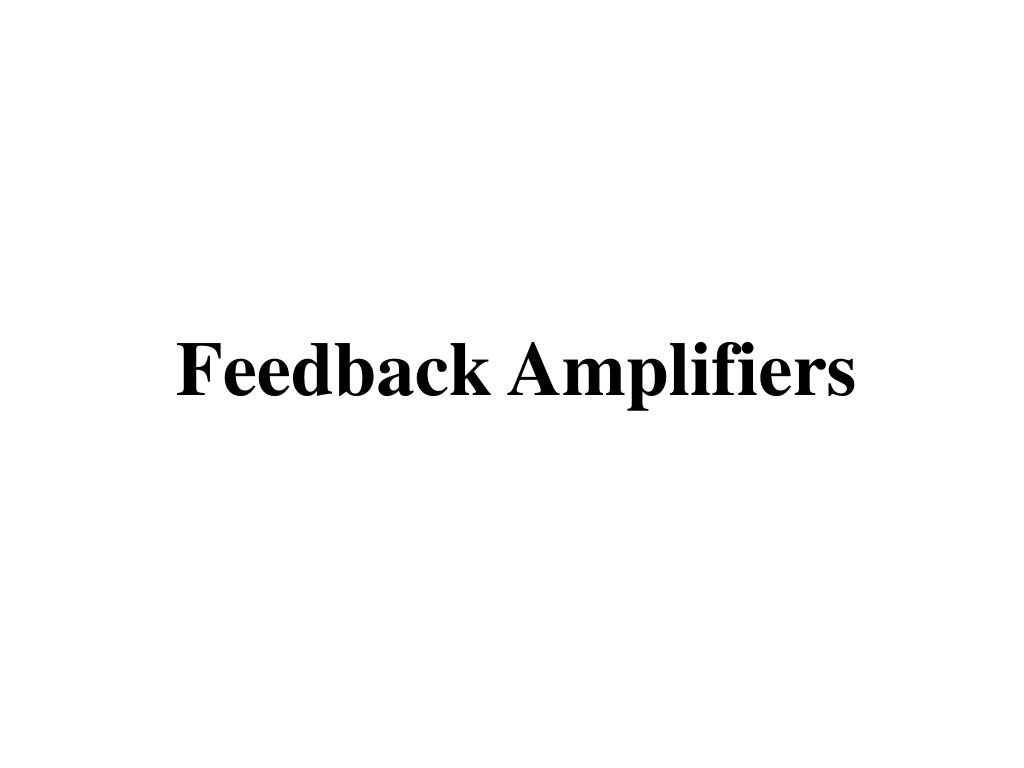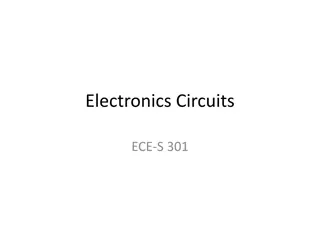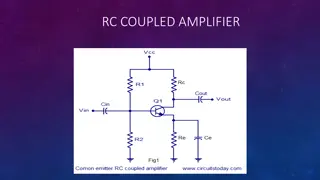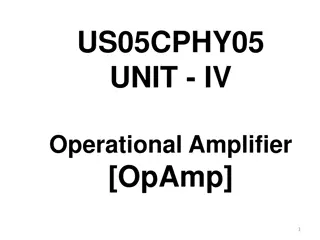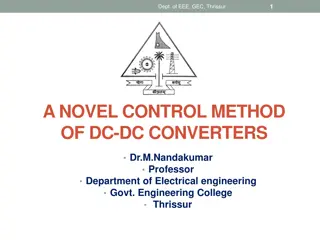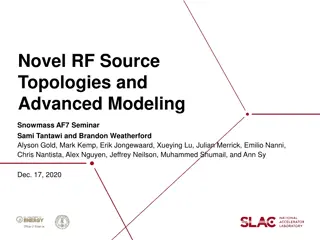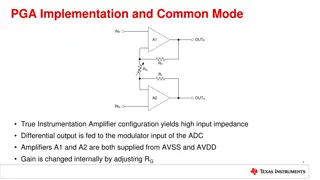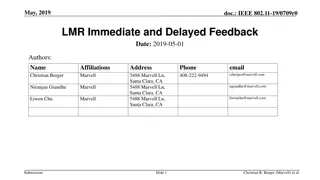Understanding Feedback Amplifiers: Structure, Properties, and Topologies
Electronic circuits rely heavily on feedback mechanisms, particularly negative feedback, for various purposes such as desensitizing gain, reducing distortion, controlling impedance, and improving amplifier bandwidth. This article explores the general structure of feedback, properties of negative feedback, and the four basic feedback topologies, along with stability analysis and frequency compensation techniques.
Download Presentation

Please find below an Image/Link to download the presentation.
The content on the website is provided AS IS for your information and personal use only. It may not be sold, licensed, or shared on other websites without obtaining consent from the author. Download presentation by click this link. If you encounter any issues during the download, it is possible that the publisher has removed the file from their server.
E N D
Presentation Transcript
Outline Introduction The general feedback structure Some properties of negative feedback The four basic feedback topologies The series-shunt feedback amplifier The series-series feedback amplifier The shunt-shunt and shunt-series feedback amplifier
The stability problem Stability study using bode plot Frequency compensation
Introduction It s impossible to think of electronic circuits without some forms of feedback. Negative feedback Desensitize the gain Reduce nonlinear distortion Reduce the effect of noise Control the input and output impedance Extend the bandwidth of the amplifier
The basic idea of negative feedback is to trade off gain for other desirable properties. Positive feedback will cause the amplifier oscillation.
The General Feedback Structure This is a signal-flow diagram, and the quantities x represent either voltage or current signals.
The General Feedback Equation Closed loop and open loop Closed loop gain x A = o A f + 1 x A s Feedback factor Loop gain A Amount of feedback (1+ A )
Some Properties of Negative Feedback Gain desensitivity dA 1 dA f =1 + A A A f Bandwidth extension Noise reduction Reduction in nonlinear distortion
The Four Basic Feedback Topologies Voltage amplifier---series-shunt feedback voltage mixing and voltage sampling Current amplifier---shunt-series feedback Current mixing and current sampling
Transconducatnce amplifier---series- series feedback Voltage mixing and current sampling Transresistance shunt feedback Current mixing and voltage sampling amplifier---shunt-
The Series-Shunt Feedback Topologies voltage-mixing voltage-sampling (series shunt) topology
The Amplifier with Series-Shunt Feedback voltage-mixing voltage-sampling (series shunt) topology
The Shunt-Series Feedback Topologies current-mixing current-sampling (shunt series) topology
The Amplifier with Shunt-Series Feedback current-mixing current-sampling (shunt series) topology
The Series-Series Feedback Topologies voltage-mixing current-sampling (series series) topology
The Amplifier with Series-Series Feedback voltage-mixing current-sampling (series series) topology
The Shunt-Shunt Feedback Topologies current-mixing voltage-sampling (shunt shunt) topology
The OP Amplifier with Shunt-Shunt Feedback current-mixing voltage-sampling (shunt shunt) topology
The Series-Shunt Feedback Amplifier The ideal situation The practical situation summary
A unilateral open-loop amplifier (A circuit). An ideal voltage mixing voltage sampling feedback network ( circuit). Assumption that the source and load resistance have been included inside the A circuit.
The Ideal Situation Equivalent circuit. Rif and Rof denote the input and output resistance with feedback.
Input and Output Resistance with Feedback Input resistance = + 1 ( i ) R R A In this case, the negative feedback increases the input resistance by a factor equal to the amount of feedback. if
Output resistance R =1 o R of + A In this case, the negative feedback reduces the output resistance by a factor equal to the amount of feedback.
The Practical Situation Block diagram of a practical series shunt feedback amplifier. Feedback network is not ideal and load the basic amplifier thus affect the values of gain, input resistance and output resistance.
The Practical Situation The circuit in (a) with the feedback network represented by its h parameters.
The Practical Situation The circuit in (b) with h21 neglected.
The Practical Situation The load effect of the feedback network on the basic amplifier is represented by the components h11 and h22. The loading effect is found by looking into the appropriate port of the feedback network while the port is open-circuit or short-circuit so as to destroy the feedback.
If the connection is a shunt one, short- circuit the port. If the connection is a series one, open- circuit the port. Determine the . V = 1 h 12 V 2 1= 0 I
Summary Ri and Ro are the input and output resistances, respectively, of the A circuit. Rif and Rof are the input and output resistances, respectively, of the feedback amplifier, including Rs and RL. The actual input and output resistances exclude Rs and RL. R R = = + R if in s // R R R of out L
Example of Series-Shunt Feedback Amplifier
Example of Series-Shunt Feedback Amplifier Op amplifier connected in noninverting configuration with the open-loop gain ,Rid and ro Find expression for A, , the closed-loop gain Vo/Vi , the input resistance Rinand the output resistance Rout Find numerical values
Example of Series-Shunt Feedback Amplifier
Example of Series-Shunt Feedback Amplifier V R + f = 1 V R R 1 2 s
The Series-Series Feedback Amplifier The ideal situation The practical situation summary
The Ideal Situation I Trans conductance gain A o V i
The Ideal Situation V f Tranresistance feedback factor I o
Input and Output Resistance with Feedback Input resistance = + 1 ( i ) R R A if In this case, the negative feedback increases the input resistance by a factor equal to the amount of feedback.
Output resistance = + 1 ( o ) R R A of In this case, the negative feedback increases the output resistance by a factor equal to the amount of feedback.
The Practical Situation Block diagram of a practical series series feedback amplifier.
Feedback network is not ideal and load the basic amplifier thus affect the values of gain, input resistance and output resistance.
The Practical Situation The circuit of (a) with the feedback network represented by its z parameters.
The Practical Situation A redrawing of the circuit in (b) with z21 neglected.
The Practical Situation The load effect of the feedback network on the basic amplifier is represented by the components Z11 and Z22. Z11 is the impedance looking into port 1 of the feedback network with port 2 open- circuited.
Z22 is the impedance looking into port 2 of the feedback network with port 1 open-circuited. Determine the . V = 1 z 12 I 2 1= 0 I
Summary Ri and Ro are the input and output resistances, respectively, of the A circuit. Rif and Rof are the input and output resistances, respectively, of the feedback amplifier, including Rs and RL.
The actual input and output resistances exclude Rs and RL. = + R R R if in s ' = + R R R of out L
Example of Series-Series Feedback Amplifier
